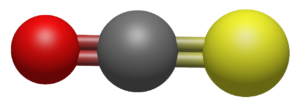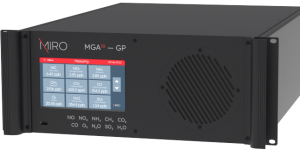
Welcome back to our “Molecule of the Month” series, where we unravel the mysteries of atmospheric gases. This month, our focus turns to Carbonyl Sulfide, sometimes abbreviated “OCS” referring to its structure or “COS” emphasizing its similarity to CO2. It is a molecule that, despite its subtle presence, holds great significance in the dynamic composition of Earth’s atmosphere. Join us on this journey as we explore the role of OCS, its sources, and the techniques employed to measure its levels in the air.
Carbonyl Sulfide (OCS) is a colorless, odorless gas composed of one oxygen, one carbon, and one sulfur atom (O=C=S). Though it might not grab headlines like its more famous atmospheric counterparts, OCS plays a pivotal role in various atmospheric processes.
The importance of OCS can be summarized by three main effects:
1. Global Sulfur Cycle: As the most abundant naturally occurring sulfur compound in our atmosphere, OCS is an integral part of the global sulfur cycle. Participating in the transport, distribution and transformation of sulfur, investigating OCS fluxes helps understanding the global sulfur cycle.
2. Tracer for Gross Primary Production (GPP): The atmospheric OCS budget is mainly dominated by fluxes from the ocean and specific anthropogenic emissions and the uptake by plant leaves on land. Similar to its carbon dioxide (CO2) counterpart, OCS can enter leaves for photosynthesis and is destroyed by plant cells. Because the CO2 budget is more complex with emissions and sinks at the same time and place, OCS is a potential tracer on the atmospheric carbon cycle as it is relatively inert in the atmosphere.
3. Stratospheric Chemistry: Besides volcanic eruptions, most of the sulfur that reaches the stratosphere is OCS because it is the longest-lived sulfur compounds found in the troposphere. Therefore, OCS is the dominant precursor of sulfate aerosols in the stratosphere, in the layer at about 15 to 50 km altitude. These aerosols have strong cooling radiative forcing by reflecting incoming sun light.

The sources of OCS in the atmosphere are:
Natural Sources: OCS is released through natural processes such as volcanic eruptions, marine emissions, and the decay of organic matter. These natural sources contribute to the baseline levels of OCS in the atmosphere.
Anthropogenic Sources: Human activities, including industrial processes and the burning of fossil fuels, release OCS into the atmosphere. Understanding the interplay between natural and anthropogenic sources is crucial for assessing the overall impact on atmospheric composition.
Manifold different methods to measure OCS in the atmosphere are currently available. The most common ones are:
Chemiluminescence Detection:
Chemiluminescence detection involves the reaction of OCS with specific reagents, producing light that is then quantified to determine OCS concentration. While this method is highly sensitive, it often requires careful control of experimental conditions and can be influenced by interfering compounds. Additionally, chemiluminescence detection may have limitations in terms of selectivity for OCS in the presence of other sulfur-containing species.
Proton Transfer Reaction Mass Spectrometry (PTR-MS):
PTR-MS is a sensitive technique that measures OCS by detecting the mass-to-charge ratio of ions formed during proton transfer reactions. This method provides real-time measurements with high sensitivity, making it suitable for field campaigns and atmospheric monitoring. However, PTR-MS may face challenges in distinguishing between isobaric compounds, potentially leading to misinterpretation of results.
Chemical Ionization Mass Spectrometers (CIMS):
CIMS involves ionizing OCS molecules through chemical reactions and then analyzing the resulting ions using mass spectrometry. This technique provides high sensitivity and specificity, allowing for selective measurement of OCS in complex atmospheric matrices. However, CIMS may have limitations in terms of the potential for interferences and the need for careful calibration to ensure accuracy.
Cavity Ring-Down Spectroscopy (CRDS):
CRDS is a highly sensitive and precise technique that measures the rate at which light decays within a high-finesse optical cavity. This decay is proportional to the concentration of OCS in the sample. CRDS offers excellent detection limits and is suitable for both laboratory and field applications. However, CRDS instrumentation can be complex and costly, limiting its accessibility for some research applications.
Fourier-Transform Infrared Spectroscopy (FTIR):
FTIR is a powerful technique that measures the absorption of infrared light by OCS molecules. FTIR is versatile and widely used in laboratory and field settings for its accuracy and ability to simultaneously measure multiple gases. However, FTIR measurements can be influenced by interference from other atmospheric constituents, may lack of sensitivity, requiring careful spectral analysis and correction.

Here, at MIRO Analytical, we use direct laser absorption spectroscopy in the mid-infrared region to monitor OCS together with up to 9 other gases. This technique offers high sensitivity, selectivity, and real-time monitoring capabilities, making it ideal for capturing dynamic changes in OCS levels as it is done in Eddy covariance measurements of the biosphere. Its precision, wide dynamic range, and non-destructive nature contribute to its effectiveness in providing accurate and reliable atmospheric data. Its direct measurment of OCS is less susceptible to interference from other gases, making it suitable for diverse applications in research, atmospheric and environmental monitoring, and industry.
Conclusion:
Carbonyl Sulfide OCS, though existing in trace amounts, plays a crucial role in shaping our understanding of atmospheric processes. From its involvement in global sulfur cycles to its potential as a carbon dioxide tracer, OCS offers valuable insights into the intricate web of interactions within Earth’s atmosphere. As we continue our journey through the world of atmospheric molecules, let’s remember that even the subtlest components contribute to the grand symphony of our environment. Join us next month as we delve into another fascinating molecule that influences the dynamic dance of gases around us. Remember: You cannot manage what you cannot measure!